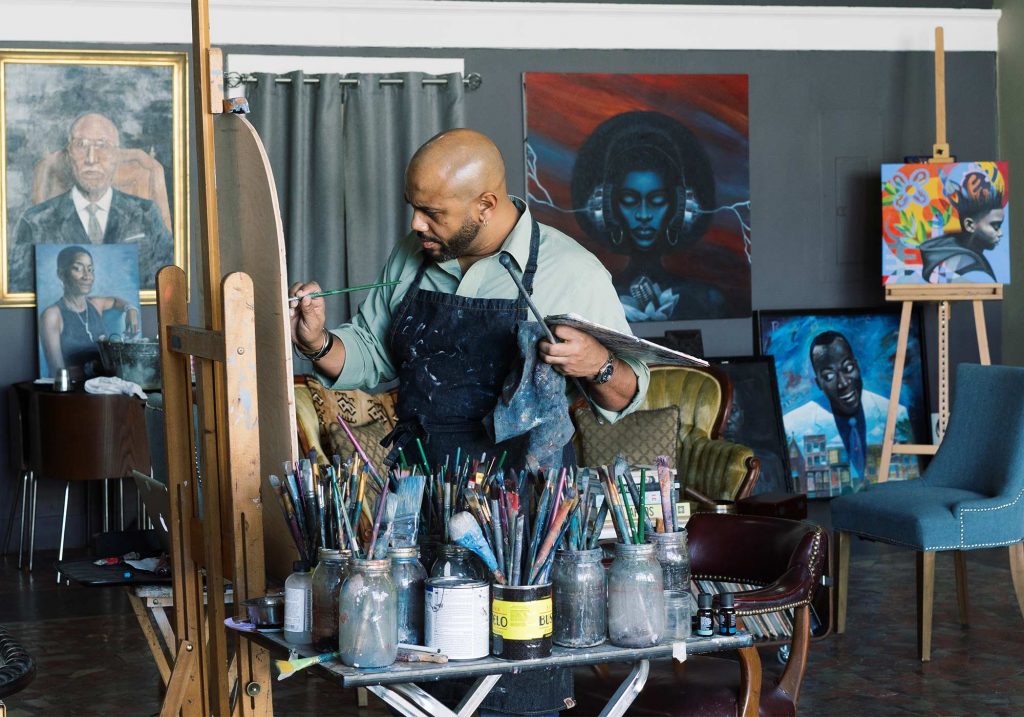In a Southside Richmond studio, accomplished Virginia Artist S. Ross Browne uses art to answer historical questions about Blackness and oppression at a time in history when his subjects are more relevant than ever. His work, primarily on canvas, presents an alternative mythology to the Western art historical tradition, which has systematically limited the representation of Black subjects and artists to oppressive tropes. As regards his work and recent events, Browne comments, “my work has always been, in part, a reflection of the various crises of identity, culture and the cancer of systemic racism. The racism has always been there and so has the effect it has had on the artists and writers and creatives of color. The rigors of being Black are not new to Black people, but what seemed to be obvious injustice meted out on people of color everyday is only now being given the attention it deserves.”

Browne is working on a series of figurative paintings of people he describes as “actors in my visual panoply.” Browne’s painterly renderings of majestic Black people surrounded with fantasy objects like crowns, swords and animal totems, as well as modern items like headphones and clothing, pull from a variety of art historical traditions, such as Renaissance portraiture and Symbolism. These paintings allow engagement with the very canon that has long rejected Blackness. Browne’s “actors” are rendered with beauty, dignity and agency. He is trying, Browne says, “to reconcile with our documented place in history, or lack thereof.”
S. Ross Browne’s Creative Process
Browne also utilizes historical precedent in his studio. An Empire sofa with velvet fabric, canvases in various states of completion and a grey cat named Bloo (on Instagram at @bloothestudiocat) look like an atelier from 150 years ago…if you overlook the record player and stacks of vinyl. Browne works in marathon stretches, often into hours that blur the lines between night and morning. Paintings are plotted and designed before the initial brushstroke. “By the time I get to the painting phase, all the contemplation is over. It’s me transcribing, basically.” Browne plays an audiobook, usually some sort of whodunit or mystery with what he describes as a “nice long time. I’ll be painting for a good solid 14 to 16 hours at a stretch. It makes it so 12 hours go by and it’s nothing—just me, doing math on a canvas.”
S. Ross Browne’s Roots in Richmond & Charlottesville
Browne’s talent for art has been nurtured and supported since he was a boy. Raised in Richmond by his mother’s brother and his wife following the death of his mother, Browne grew up in a home where art, and his interest in it, was cultivated. In his new home, he poured over art books featuring Chagall and Van Gogh, as well as the sci-fi fantasy Artist Frank Frazetta. His Aunt Carol encouraged him to draw and paint, and framed his efforts.
As an adolescent, Browne became a boarder at The Miller School in Charlottesville. In the 1980s, the school was all boys and military-oriented, with very few other Black students. There was no arts program. “I changed people’s opinions about Black folk…those same people, who may have harbored certain views, are people I now consider my brothers,” Browne says, reminiscing.
“I changed people’s opinions about Black folk…those same people, who may have harbored certain views, are people I now consider my brothers.”
Without a formal arts program, Browne drew and painted on his own. “Eventually, the school took notice,” he says. While a military-style school may sound like a mismatch for a budding artist, Browne points out that many generals and military men like Patton and Churchill were excellent artists. Miller School’s Dean, Charles Leonard, had his niece Pam Hammock offer an art class. Browne didn’t just take the class, he quickly began to help teach it. The “fantastic” arts program at Miller is something “that they blame me for,” Browne laughs. The school still displays his drawing of founder Samuel Miller, signed with his name and age, 15, and invites him back each year to judge the Honors Show.

Discovering the Path to Becoming A Professional Artist
For someone who is now so singularly focused on art making, Browne was a well-rounded student who played sports and seriously considered a career in medicine. He ultimately decided, however, to nurture his artistic talents. “I knew I would regret it if I didn’t use this gift I had been given. Imagine getting this gift, it’s nicely wrapped, and given by someone who knows you and loves you. And you say, ‘wow, what a wonderful gift! This is the best gift ever…You know me so well, but no thank you,’ and you throw it back in their face. So, I decided to see where it would go.”

After graduating from Miller, Browne attended a program at the Corcoran and then enrolled at Virginia Commonwealth University (VCU), intending to pursue his bachelor of fine arts. He left VCU before completing his degree, and, like many artists before and after him, took a job waiting tables in order to be able to make as much art as possible. Browne learned to walk a fine line. “The equivalent of being sensible as an artist is going into illustration,” he remarks, but success as an illustrator made it harder to do the fine art paintings that Browne envisioned. He has learned to blend the two different responsibilities in order to keep the studio lights on. In both of these genres—illustration and fine art—the representation of Black and Brown bodies with dignity, beauty and historical reference remains central.
In addition to his serious work as an artist, Browne has a separate string of experiences in popular media, beginning with acting as an extra in the Jon Cryer vehicle Morgan Stewart’s Coming Home, which was filmed at The Miller School when Browne was a student. More recently, in 2016, Browne appeared in Skin Wars: Fresh Paint, a reality competition hosted by RuPaul. For that, Browne was required to transfer his artistic skills from canvas to the human body. He was also part of “Work of Genius,” living and competing with fellow artists for a month in Miami. While Browne has enjoyed these experiences and understands the importance of the exposure they offer, he isn’t interested in gaining television notoriety.
When discussing his appearance on Skin Wars, he had trouble recalling his episode number, confessing he’s never watched it (or Morgan Stewart’s Coming Home). If interested in viewing either, you’ll see Browne comport himself with a dignity at great odds with the majority of reality television: this is the same dignity he gives to the actors in his paintings.
Instead of pursuing acting, though, Browne will continue to devote his time to painting and the therapeutic art classes he’s been conducting since the 1990s. Browne leads participants of all ages through a guided meditation and painting process that utilizes a mandala and symbols to help people “compartmentalize and get ahold of the good and the chaos,” he says.
Tension between our best and worst visions informs Browne’s other painting projects. In a series called “The Apotheosis,” he strives “to show the beauty that is not always apparent; to show the possibilities of being your highest self… The work is about how it looks to be in that highest self, and how we can have true compassion. We can see God in each other,” Browne promises. “But, I also have another side, dystopian work. The working title is a Latin phrase, ‘In Edem Omnus Navi’ [we are all on the same boat] that shows us waking up without that vision. It’s visually interesting, and a challenge as an artist.”
As he ponders these two extremes of humanity, and as he teaches and informs others through his workshops and paintings, Browne assures his own place in the historical narrative within the myths he has created, and at a time when voices such as his are more important than ever. ~
This article appears in Book 10 of Wine & Country Life. To find even more articles on Virginia artists, authors and musicians, see our Style & Culture page.
A resident of Albemarle County, CATHERINE MALONE has written for Wine & Country since its inception.














